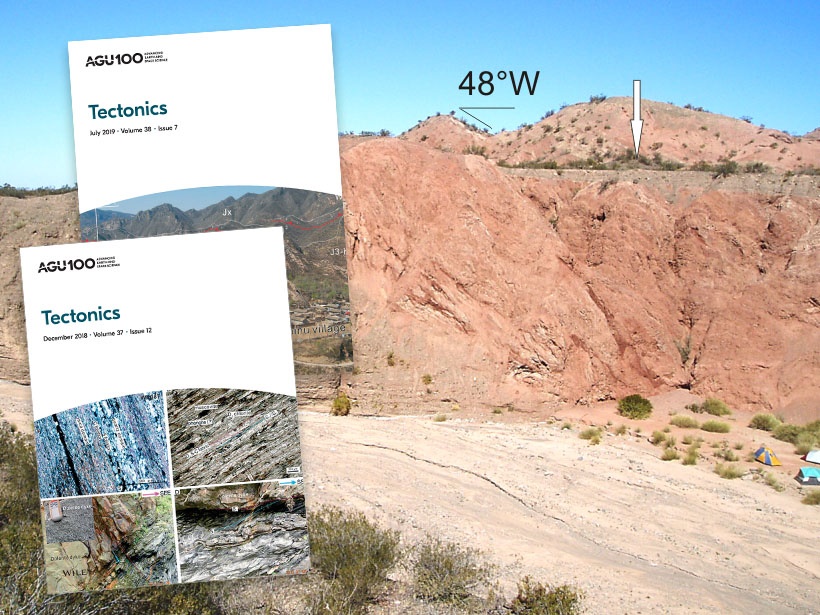A very tried and true adage is that life’s only constant is change, and with that we enthusiastically report that John Geissman has ended his eight-year term as Editor in Chief for Tectonics. He has been replaced at the helm by Taylor Schildgen, who began her tenure on 1 January 2020. Taylor has previously served as an Associate Editor for the journal for four years and Editor for the past two years.
John began his term as EiC with two major goals for the journal. The first was to introduce special sections, which are collections of papers devoted to a common theme, such as a particular geographic region of focused tectonics research, or a specific tectonic process. The second was to broaden the scope of Tectonics to include work on the margins of the continents. We believe that both goals have been accomplished with considerable success.
Encouraging Statistics
We are happy to report that the journal, by many measures, is in excellent shape.
We are happy to report that the journal, by many measures, is in excellent shape, with an impact factor of 3.98 for 2018/2019. For comparison, among non-AGU journals in this field, Tectonophysics has an impact factor of 2.68 and Lithosphere 2.76. We also have a five-year rolling impact factor of 4.81 and a total of about 11,300 citations in 2018.
The scientists who publish in our journal reported an overall satisfaction rate of 4.5 to 4.3 with their experience in the most recent survey.
We reached a record high of 443 papers submitted in 2018, which we surpassed in 2019 with 473 submissions, in comparison to less than 300 submissions less than ten years ago. About half of submitted papers used to get accepted for publication, but this has now dropped to about 45 percent.
Presently, over a third of manuscripts submitted to Tectonics originate from China, and this number continues to increase. In comparison, about 11 percent of submissions originate from the United States and about 17 percent from the UK, France, and Germany combined. Across all AGU journals together, almost one-third originate from the United States and about one-third from China.
Improving Editorial Representation
We are working to increase the number of Associate Editors from China, as well as the representation of women on the editorial board.
To handle the increasing number of submissions and to better reflect the geographic diversity and gender balance of our submissions, we are working to increase the number of Associate Editors from China, as well as the representation of women on the editorial board. Toward these aims, the nine of the new Associate Editors appointed in January 2020 include five women and three researchers based in China or Southeast Asia.
With the enlarged editorial board, we also aim to expedite the time it takes to find reviewers for each manuscript and to send authors the editorial decision about their paper. The median time to first decision has held fairly steady over the last three years at between 70 and 72 days. With timely help from our reviewers, we believe it will be possible to trim down these numbers.
As always, we will continue to work with authors to ensure reasonable publication costs. Our aim is to ensure that fees and charges will not be a hindrance to publishing high quality work in Tectonics. AGU kindly offers fee waivers and discounts for researchers from developing countries and those unable to pay; just ask the editor if you think you are eligible and would like to be considered.
Special Collections
We published several special issues in the journal over the past seven years. One of the highlights was Fifty Years of Plate Tectonics, which originated from the Summer 2018 special celebration meeting in Paris, and has been guided along by Guest Editors, Eric Calais, Barbara Romanowicz, and Claude Jaupart.
We urge the community to submit proposals for new special collections.
We urge the community to submit proposals for new special collections. The process of doing so is simple. Simply contact one or several of the journal’s editors to discuss ideas, then complete a short proposal form. The proponents of a special collection act as its Guest Editors, and they work with one of the regular editors to handle all the manuscripts.
The journal has also participated in celebrating AGU’s Centennial by commissioning several papers for the Grand Challenges in the Earth and Space Sciences special collection. One of these is “Innovations in (U–Th)/He, Fission Track, and Trapped Charge Thermochronometry with Applications to Earthquakes, Weathering, Surface‐Mantle Connections, and the Growth and Decay of Mountains” [Ault et al, 2019], but several others are nearing publication.
Challenges Ahead
One of the key challenges and opportunities we currently face is ensuring that all manuscripts published in Tectonics (and across the full range of AGU journals) comply with the FAIR data standards. We are working toward providing authors with suggestions for both general and discipline-specific data repositories that comply with these standards. As this process will likely evolve over time, we encourage authors to engage with us regarding any suggestions they may have to facilitate achieving this milestone in publication standards and data access.
—Taylor Schildgen ([email protected]; ![]() 0000-0002-4236-4609), GFZ German Research Centre for Geosciences; and John Geissman ([email protected];
0000-0002-4236-4609), GFZ German Research Centre for Geosciences; and John Geissman ([email protected]; ![]() 0000-0001-7526-2724), University of Texas at Dallas
0000-0001-7526-2724), University of Texas at Dallas
Citation:
Schildgen, T.,Geissman, J. (2020), Editorial handover at Tectonics, Eos, 101, https://doi.org/10.1029/2020EO139723. Published on 04 February 2020.
Text © 2020. The authors. CC BY-NC-ND 3.0
Except where otherwise noted, images are subject to copyright. Any reuse without express permission from the copyright owner is prohibited.

